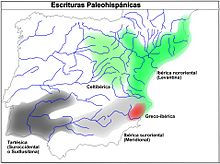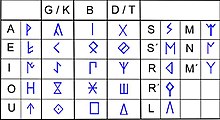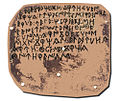Old Hispanic writings

The Old Hispanic scripts are the writing systems that were used before and at the beginning of Roman rule on the Iberian Peninsula . Most of them are typologically very unusual in that they are half-syllable scripts rather than real alphabets , although they evolved from the Phoenician alphabet .
The ancient Hispanic scripts were used from the 5th century BC - according to some researchers, from the 7th century - to the end of the 1st BC or the beginning of the 1st century AD and were the main means of recording the ancient Hispanic languages in writing. Some researchers argue that they are solely derived from the Phoenician alphabet, while others believe that the Greek alphabet also played a role.
Fonts
The Old Hispanic scripts are divided into three main groups, Southern, Northern and Graeco-Iberian, with differences in both the shapes of the characters and their phonetic values.
Inscriptions of the southern scripts were mainly found in the southern half of the Iberian Peninsula, represent only 5% of the total inscriptions found so far and are almost always written from right to left. It is about:
- the Espanca character set (known from a single tablet, and the only evidence of an alphabetical order);
- the Tartessian or South Lusitan script , also known as Southwestern;
- the Southeast Iberian script , also known as Meridional .
Inscriptions of the northern scripts were found mainly in the northeast quarter of the Iberian Peninsula, representing 95% of all inscriptions found and are almost always written from left to right. It is about:
- the Northeast Iberian script , also known as Levantine ;
- Dual variant
- Non-dual variant
- the Celtiberian script
- Western variant
- Eastern variant.
Besides, there was
- the Graeco-Iberian alphabet .
The latter was a direct development from the Ionic variant of the Greek alphabet and was limited to a small region on the Mediterranean coast of what is now the provinces of Alicante and Murcia .
The southern scripts were written right to left like the Phoenician alphabet, while the northern scripts reversed left to right like the Greek alphabet.
South lusitan script . Stele from Fonte Velha (Bensafrim, Lagos ).
Southeast Iberian script . Lead sheet from La Bastida de las Alcusas ( Mogente ).
Graeco-Iberian alphabet . Lead sheet from La Serreta ( Alcoy ).
Northeast Iberian script . Lead sheet from Ullastret ( Girona ) (see IV a. C.).
Celtiberian script . Bronze plaque from Luzaga ( Guadalajara ).
See also
- Graeco-Iberian alphabet
- South lusitan script
- Southeast Iberian script
- Northeast Iberian script
- Celtiberian script
literature
- Correa, José Antonio (2004): “Los semisilabarios ibéricos: algunas cuestiones”, ELEA 4, pp. 75–98.
- Ferrer i Jané, Joan (2005): “Novetats sobre el sistema dual de diferenciació gràfica de les oclusives sordes i sonores” ( Memento from February 15, 2012 in the Internet Archive ) (PDF; 244 kB), Palaeohispanica 5, p. 957– 982.
- Hoz, Javier de (2005): “The recepción de la escritura en Hispania como fenómeno orientalizante”, Anejos del Archivo Español de Arqueología XXXV , pp. 363-380.
- Rodríguez Ramos, Jesús (2000): “La lectura de las inscripciones sudlusitano-tartesias” (PDF; 192 kB), Faventia 22/1, pp. 21-48.
- Untermann, Jürgen : Monumenta Linguarum Hispanicarum, Wiesbaden. (1975): I The Coin Legends. (1980): II The Iberian inscriptions from southern France . (1990): III The Iberian inscriptions from Spain . (1997): IV The Tartessian, Celtiberian and Lusitanian inscriptions .
- Velaza, Javier (2004): “La escritura en la península ibérica antigua”, La escritura y el libro en la antigüedad , Madrid, pp. 95–114.
Web links
Individual evidence
- ^ Correa, José Antonio: Del alfabeto fenicio al semisilabario paleohispánico. In Revista sobre lenguas y culturas de la Histania antidua 5. Palaeohispanica 5, Zaragoza, 2005, pp. 137-154.
- ^ Jürgen Untermann: Monumenta Linguarum Hispanicarum. Wiesbaden 1975, I The Coin Legends. 1980; II The Iberian inscriptions from the south of France. 1990; III The Iberian inscriptions from Spain. 1997; IV The Tartessian, Celtiberian and Lusitan inscriptions.











